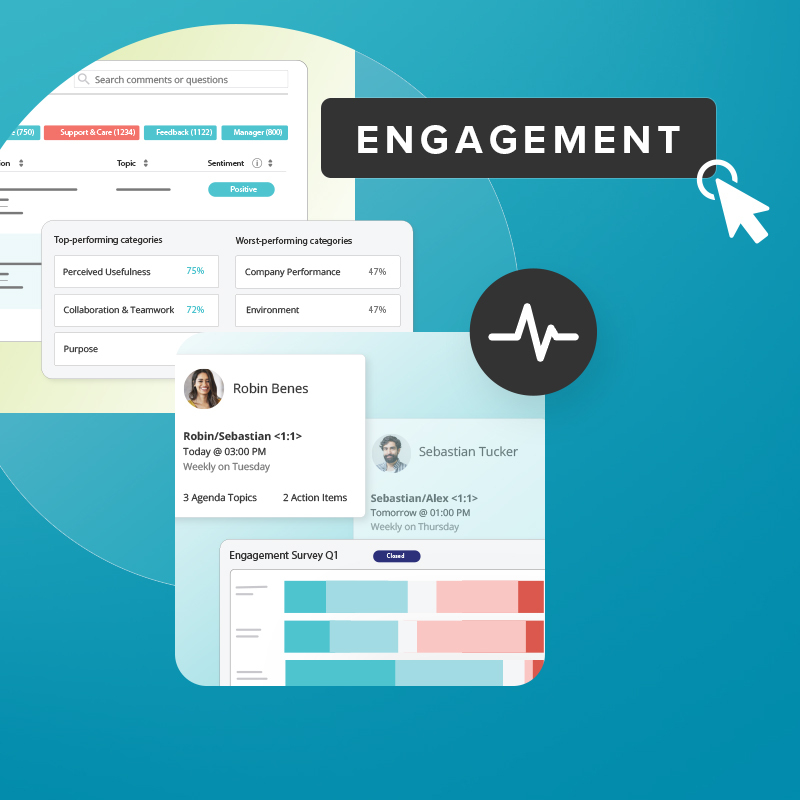As industries and technologies change, we must continuously adjust our methods for interacting with and engaging employees. But engagement is more than just a yearly engagement survey and an occasional offsite or in-office activity that’s assumed to increase engagement. Engagement means listening to the needs of your employees and finding unique ways to build rapport and relationships with them.
Additionally, it means collecting people analytics through continuous engagement strategies that enable you to see the physical data on how your employees think, feel and interact with your current system. Using this data, you can create a more thorough action plan to improve. Engagement is an important factor of labor costs, profitability, productivity and even employee retention. Check out these industry statistics and see the web of value people analytics and engagement builds within your business:
Engagement at a Glance
- 89% of senior managers feel that their company is actually very good at recognizing their workers. (Incentive)
- 70% of employees say they aren’t engaged at work. (Undercover Recruiter)
- Organizations with high employee engagement outperform those with low employee engagement by 202%. (Business2Community)
- Disengaged employees cost organizations between $450 and $550 billion annually. (The Engagement Institute)
- Businesses with highly engaged employees earn twice the annual net income of those with disengaged employees. (The Muse)
- Productivity improves by 20-25% in organizations with connected employees. (The McKinsey Global Institute)
With regards to profitability and cost, engagement has both positive and negative lenses. Engaged employees are more productive than disengaged employees and bring in more capital gain. A vast majority of workers are not engaged, even though their executives seem to think they are. These disengaged employees increase costs and bring competitive disadvantages to their firms. In essence, businesses won’t survive in their market if they fail to recognize the need for engagement.
The Need for More Feedback
- 79% of employees cite ‘lack of appreciation’ as their reason for quitting their jobs. (O.C.Tanner)
- Only 53% of businesses measure employee engagement. (Forbes)
- Only 24% of all employees fall into the “Highly Engaged” category and another 39% can be categorized as “Moderately Engaged.” (AON Hewitt study)
- Only 39% of senior leaders prioritize engagement, and only 28% of senior leaders have managers who have solid skills at fostering engagement. (Inspire Software)
Engagement as Positive Reinforcement
- 70% of employees ranked being empowered to take action at work when a problem or opportunity arose as an important element of their engagement. (SHRM)
- Employees who feel their voice is heard at work are 4.6 times more likely to feel empowered to perform their best work. (Salesforce)
- 84% of HR leaders say an employee recognition program helps employee engagement. (Globoforce)
- Roughly 7 out of 10 employees claim they would work harder if they felt their efforts were recognized. (LinkedIn 2016)
Employees want to be empowered in their line of work and have their voice heard. These are both key elements to boosting employee engagement. Encouraging employees to voice ideas and concerns helps them feel valued to the company and in the work they do. Who doesn’t enjoy feeling important and wanted at their job?
Engagement as Retention
- 36% of businesses see engagement as their number one challenge ahead of employee retention, turnover, recruitment, succession planning, culture management and performance management. (GloboForce 2016)
- 66% of employees say they would likely leave their job if they didn’t feel appreciated. (Forbes)
- 76% of millennials who don’t feel valued at work are seeking other job opportunities. (Forbes)
- Engaged employees are 87% less likely to leave their job. (The Muse)
- 55% of businesses think that stronger engagement would improve their ability to either retain, recruit or carry out succession planning. (CBI)
Opening the Door for Betterworks Engage
- The most popular methods to actively manage and drive employee engagement: drafting employee engagement surveys (55%), creating culture committees and events (29%) and offering employee resource groups (20%). (CultureIQ)
- 92% of employees say that having the technology to do their job efficiently affects their work satisfaction. (Ultimate Software)
- 58% of employers are looking to create a brand strategy that enhances employee engagement and improves the employee experience. (Blu Ivy)
- 58% of business leaders said their technology offerings are a factor in candidates’ decisions to work for them and 51% said outdated technology hampers their ability to compete for talent. (Harvard Business Review)
- 71% of millennials say an organization’s view of technology will influence whether they want to work there and 66% of Gen Xers and 53% of baby boomers feel similarly. (CompTI)
As companies work to increase engagement, it is vital that they have the best technologies available to help them achieve their engagement goals. Employees want it and the industry practically demands technological innovation for businesses to survive and retain talent.
Betterworks Engage brings all of these together to offer a unique engagement model wherein businesses can create a culture of feedback and networking. With its top-down approach to feedback, Betterworks Engage’s surveys and polls match with bottom-up crowdsourced employee conversations to gauge the pulse of your employee engagement in real-time. This gives you access to a gold-mine of people data to proactively take action on issues which need immediate attention. After all, true engagement comes with listening from the intent of doing. Request your demo and start listening to your employees anytime, anywhere.




